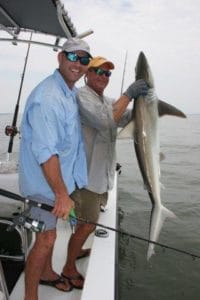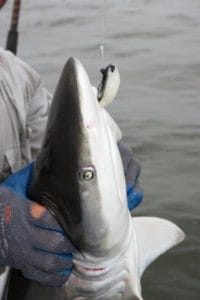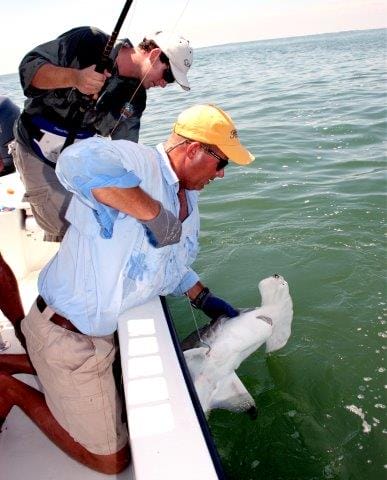by Bob McNally
It was a gray, slick-surface morning; hot and sticky even for nearshore Georgia, but a perfect setting was emerging for dead-drift saltwater fishing.
Charter captain Greg Hildreth, of Brunswick, looked left and right along the southeast Georgia coast. He took careful note of the current and tide, then declared the spot was just right off beautiful and scenic Cumberland Island to put out baits and chum a bit.
We were looking for tarpon, trying to locate the first silver kings for friends Jake Markris and Kevin Olmstead, visiting from their homes in Fairhope, Alabama. On board, too, was my son Matt, a long-time tarpon addict.
We were fishing with a couple whole, dead menhaden baits trailing astern, while chunks of cut-fish chum were tossed into the ocean and drifted back. Suddenly there was an oversize boil at the surface near some chum, then another, and another. Everyone was up, tense, and standing beside rods with baits trailing back 50 yards from our 24-foot center console boat.
A rod bowed sharply under the weight of a big fish, and Jake immediately was on it, pulling it from the gunnel holder and setting the hook hard a couple times. The fish bulldogged away, fast and straight; so powerful it slammed Jake’s knees against the side of the boat as he frantically put on a fish-fighting rod belt.
Before Jake could settle into a comfortable fight, a second rod bowed, and Kevin was soon hooked up to another drag-screaming fish.
Ten minutes into their fights neither fish had jumped, like tarpon should, and I broke the news to Jake and Kevin.
“Probably sharks guys, not tarpon,” I told them.
“Man, I don’t know what this is, but it’s big, strong, and I’m gonna get it to the boat,” Kevin growled as he put heavy rod power to his sunken adversary.
Ten minutes later Kevin drew a 75-pound blacktip shark to the boat, where Greg handled it and unhooked it. That was quickly followed by Jake’s fish, a like-size blacktip.

Blacktips and spinner sharks are common along the southern coasts. These sharks bring an added attraction—they jump like tarpon!
Soon they were laughing and high-fiving, glad for the hard fight, and ready for another go at sharks.
And that’s what we got that day—many, many times over.
Jake and Kevin each caught a tarpon that morning, nice fish that jumped and ran, fought tough and well. But it was the sharks we fought most. We caught sharks until our arms ached… blacktips and spinners that slammed jigs and jumped at least as well as our targeted tarpon. Then we caught hammerheads and small bonnet heads, with Atlantic sharp nose, duskys and we even saw a small tiger shark at the surface that refused a lure.
That’s how it is with sharks. They’re big and powerful, and while they don’t draw the attention and raves other more glamorous species do, they are hard-fighting fish that can be counted on to make a showing almost anywhere in the saltwater South.
Two of the most sporting and abundant sharks are spinners and blacktips. These sharks can be caught trolling, chumming, blind-casting, sight-casting, inshore, offshore, over reefs and wrecks and on the flats. They’re available throughout the South, and they are great light-tackle targets. Both shark species hit surface plugs, fly-cast streamer flies and poppers, as well as jigs, sinking lures and, of course, natural baits. They jump and spin, and these sharks run like unleashed piscatorial demons. And they commonly weigh 50- to 100-pounds.
It’s difficult to distinguish blacktips sharks from spinners, since both species are similarly shaped and they each have blacktip fins. Even fisheries biologists who specialize in sharks can have trouble discerning blacktips from spinners.
Many light-tackle anglers, though, could care less if the high-leaping and twisting shark at the end of their line is a blacktip or spinner. Both shark species are a joy to catch, and they’re available in the warm months to millions of Dixie anglers.
Other than blacktip, spinner and mako (rare in the South), few other sharks jump; instead preferring to fight it out deep and tough, requiring heavy tackle. These shark species generally are caught with natural baits, and they include tiger, hammerhead, dusky, sand, lemon, bull and sandbar sharks. Among this group, the bull, tiger and hammerhead are especially noteworthy because of their massive size, and their well-known reputations as man-eaters.

Sharks will readily take a variety of baits, from cut and live bait to lures and even fly-fishing streamers.
A tremendous 1,780-pound tiger shark was caught off South Carolina in June, 1964 by Walter Maxwell. This catch must rank as one of the most incredible of all time, since Maxwell caught the monster shark from the Cherry Grove fishing pier near Myrtle Beach using a 16/0 fishing outfit which held 1,400 yards of 130-pound test line. A whole skate (like a stingray) was used for bait, and the massive fish leaped twice despite its incredible bulk during the 4 1/2-hour battle. The shark made more than 30 runs, some up to three-quarters of a mile long. The fish was not weighed until 15 hours after it was caught, and many estimates are that the shark lost 10 percent of its body weight in that time. The huge tiger had a 103-inch girth and measured 13-feet, 11-inches long. Incredibly, Maxwell hooked, played, but then lost another tiger just a few days earlier that he and friends insist was much bigger than the 1,780-pounder, which is still an IGFA all-tackle record for the species.
Hammerheads are notoriously aggressive, and several different species of these sharks are caught in the South. The great hammerhead is the largest and can grow to 18 feet, with 12-footers common. While many sharks are quite shy, hammerheads are not, and they have a decided preference for live baits intended for other species like king mackerel and sailfish. Hammerheads also regularly dine on 100-pound tarpon having giant scales the size and texture of computer disks. It takes a pretty good shark to sever a giant tarpon with a single bite. But it happens almost daily wherever tarpon congregate—like Boca Grande Pass in the Florida Gulf during the the area’s famous May to June tarpon migration.
It is there that Bucky Dennis set the all-tackle world record for hammerhead in late May, 2006. That 14-foot shark weighed an incredible 1,280 pounds, but Bucky says much bigger hammerheads are available at Boca Grande when tarpon are in good supply there.
May and June are prime for oversize hammerheads at Boca Grande. Incoming tides early in the morning are best. Almost anything big and alive can be used for hammerhead bait, with jack crevalle and sting rays good choices. Baits are simply free-lined in current, without chum, and only single hooks are employed because double-hooks are too dangerous in manhandling giant sharks at boatside.
But record-weight shark fishing is specialized sport, and shark fishing for most anglers is not this heavy-duty nor sophisticated. It is usually light-tackle action primarily for blacktips, spinners, bulls and lemons. That’s good for plug, spin and fly fishermen, since most such sharks are in the 30- to 80-pound range, with occasional fish weighing more than 100 pounds. These sharks are just the right size for screaming reel drags and bending stout-action rods, but not the kind of knuckle-busting, knee-bruising brawl bigger sharks dish out.
This is great fishing for families and anglers who simply want to bend a rod on a tough, toothy customer.
Catching sharks isn’t the same sport as jumping tarpon or sight-casting to cobia. But sharks are plenty strong, and some species jump. On reasonably light tackle, casting baits or lures to feeding sharks makes your knees knock and your palms sweat—and that’s good enough for most anglers.
The Union Sportsmen’s Alliance website is designed to provide valuable articles about hunting, fishing and conservation for members of AFL-CIO affiliated labor unions and all sportsmen and sportswomen who appreciate hunting and fishing and want to preserve our outdoor heritage for future generations. If you would like your own story and experience from the outdoors to be considered for our website, please email us at [email protected].




